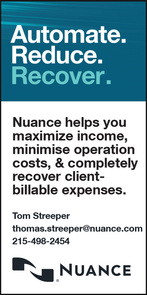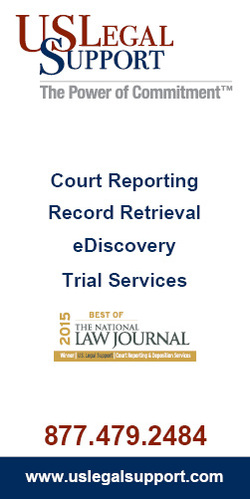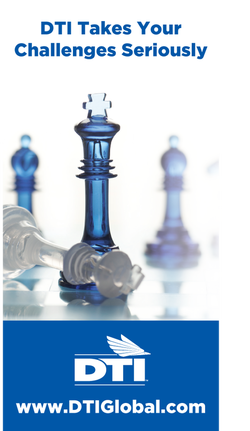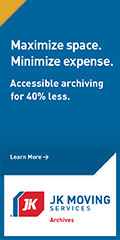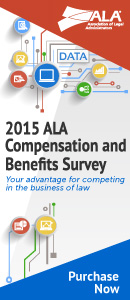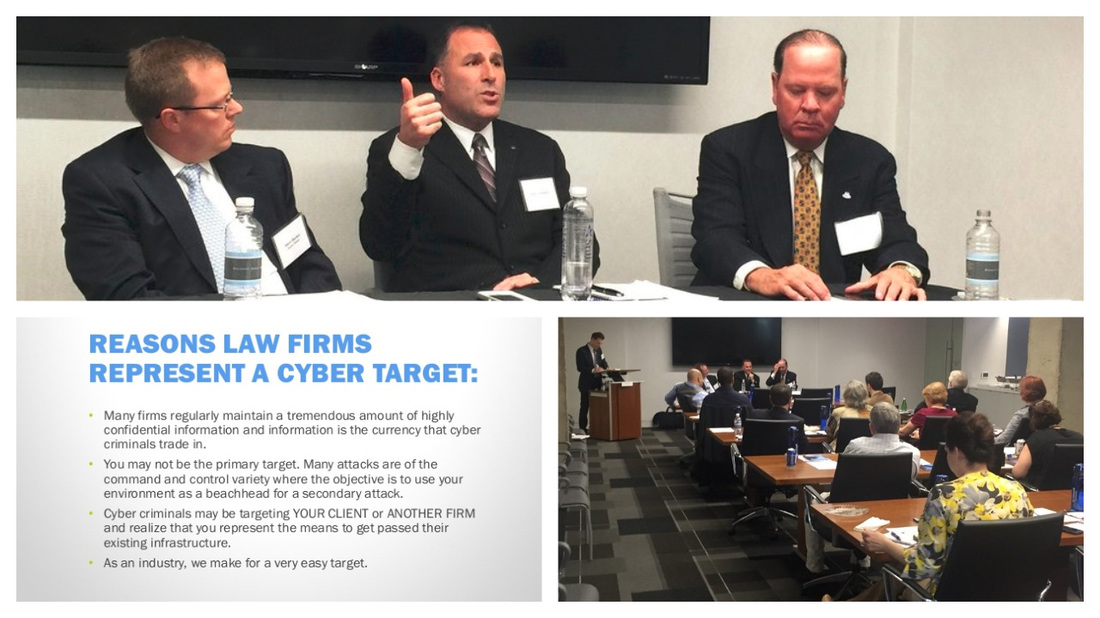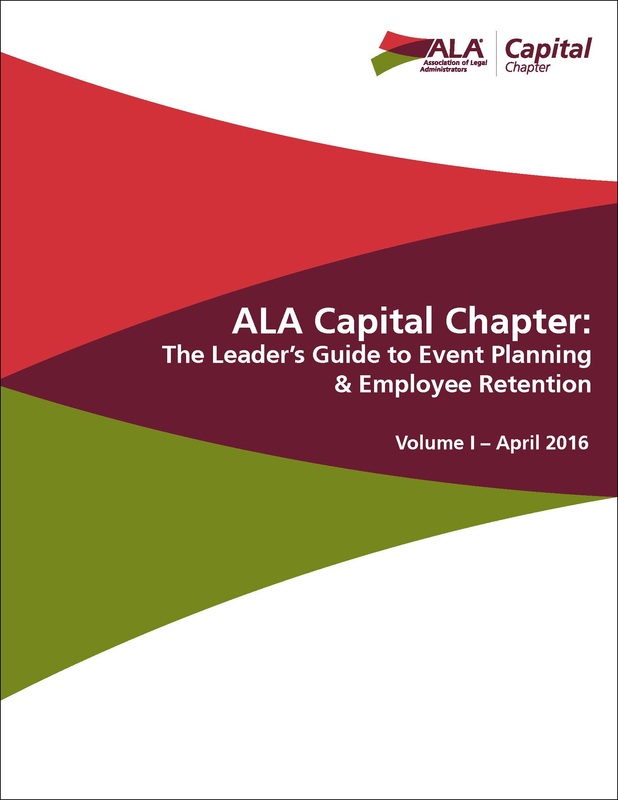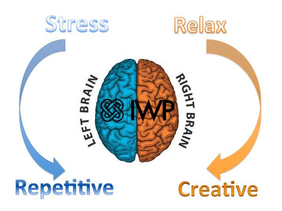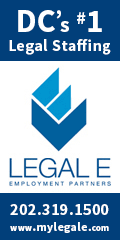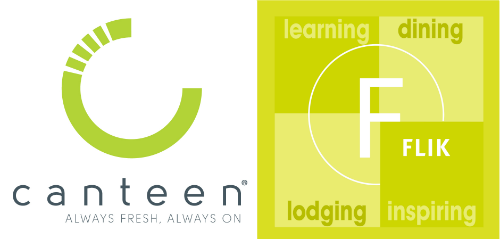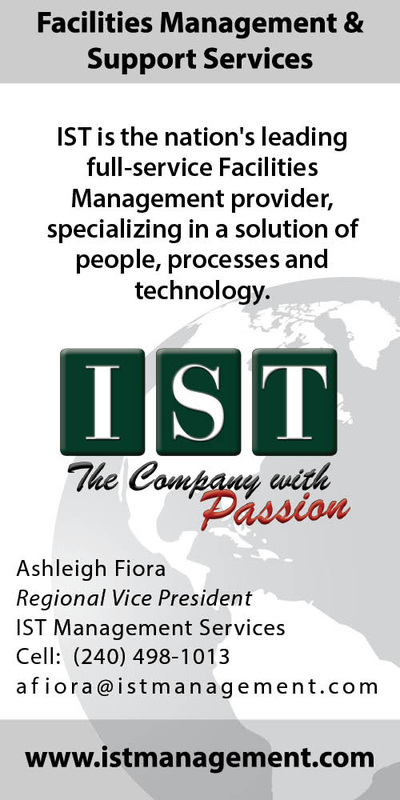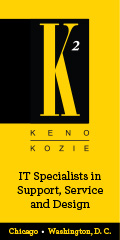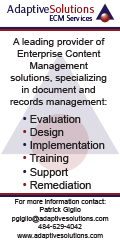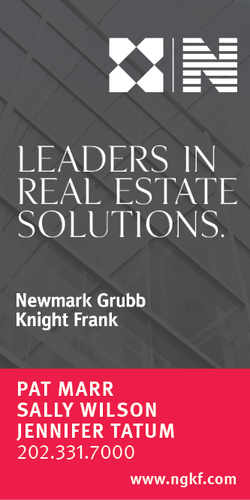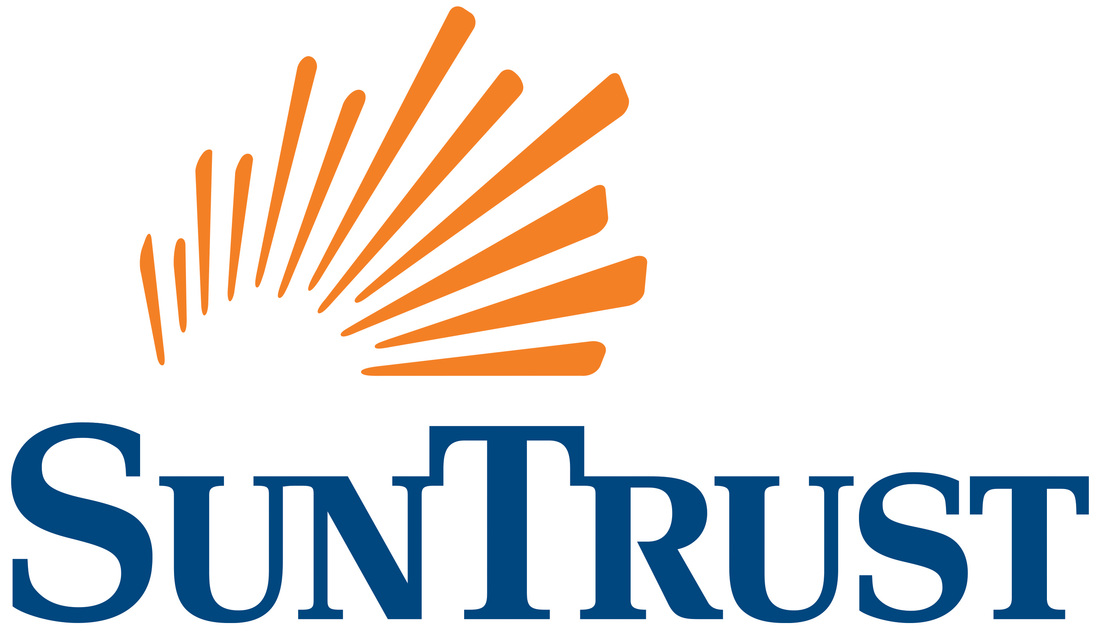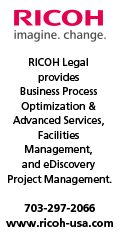| Capital Connection |
April 2016Capital Connection is published monthly for members of the Capital Chapter of the Association of Legal Administrators to provide information for the education and benefit of legal administrators, law office managers, managing partners of law firms, and other law related associations. Capital Connection is not engaged in rendering legal, financial, or tax counseling or advice through this publication. The contents of all articles, letters, and advertisements published in Capital Connection should not be considered endorsements by the Capital Chapter of ALA nor the opinion expressed therein of any products advertised. Contributing authors are requested and expected to disclose financial an/or professional interests and affiliations that may influence their writing position. Articles and materials accepted for publication are subject to editing by the editorial team and become property of the Capital Chapter of the Association of Legal Administrators. Links to Capital Connection may not be shared without permission from the Chapter.
Editor: Jacqueline Moline Associate Editors: Paula Serratore; Cindy Conover Contributing Editors: Barbara Mannix; Vanessa Partin; Matt Filimonchuk; Sahar Andrade, MB.BCh; Jessica Davis; Craig Church; Beth L. Fowler, CLM; Alex Liu; David Hemperly; Lance Breger Newsletter Designed By: Jessica Davis |
In this issue: |
Leadership Team
Welcome 2016-2017 Officers!
Executive Committee
Leadership Team
Sustainability Tip of the MonthThis month's tip is provided by Silver Business Partner Newmark Grubb Knight Frank
April 22nd is Earth Day! Use easy document scanning/emailing instead of faxing or mailing documents. This will not only reduce paper, but could also reduce your real estate costs by reducing onsite paper storage needs. To find out how to get the full value for real estate savings through greening your lease, reach out to Jennifer Tatum at Newmark Grubb Knight Frank at 202-312-5771. Miller's Supplies at Work Spotlight
Craig Church
Vice President Sales, Miller's Supplies at Work Happy Spring! As the seasons change from Winter to Spring, I’m reminded of an article I wrote for this newsletter back in 2014. The article started off with: “The only constant in this world is change.” Again, that phrase has never been truer than it is now. The office supply industry has changed dramatically over the last 5 to 10 years and is probably going to experience another big change if the FTC agrees to allow the Office Depot/Staples merger. Look at the number of national office supply dealers you had back in the year 2000. Staples, Office Depot, Office Max, Corporate Express, US Office Products and Allied Office Products were all national suppliers competing in the DC legal market for your business. Six large, healthy companies competing for your business driving prices down and services up. That’s what competition does, right? Drives down prices and raises service levels. Most people who are in the know agree that in the next six months, there will only be one national office supply vendor, Staples. For those that have been following this trend in the news, you know the FTC is concerned the result of this merger will mean higher prices and decreasing service at the national level. We all learned in our college and high school economics class that less competition means higher prices. We can all see it coming; many of you have already experienced the pain associated with the Office Max/Office Depot merger with pricing and services. The expectation should be that this is going to continue when there is only one national office products supplier. It’s not all bad news. There is a channel in our industry where competition is prevalent. That is the local independent office supply dealer community. We live and work in a market that is extremely different than most places in the country. We’re home to the Federal Government which requires and attracts a huge number of professional workers to sustain it. Our industry requires professional workers to prosper and DC has a lot of them. The result of this is several very competitive, healthy independent dealers. We compete on a daily basis to provide you with competitive pricing and we are constantly rolling out new services. Each of us has increased our investments in technology to provide you with first class e-commerce platforms that I would argue are better than our national competitor. We constantly compete with each other on pricing, resulting in the lowest office supply pricing in the country. We each have local customer service that delivers a personalized experience, no 1-800 number level of service. Tired of having all of your products dropped off at the front desk by the national company? Local dealers employ their own distribution staffs who are happy to put your products where you need them, not where it is convenient to dump. The only perceived benefits of a national company are the ability to have uniform pricing at every office, have a common platform for ordering products and one source for reporting and invoices. Each independent supplier in the DC market has the ability to provide all of those perceived benefits. If your firm is using a local supplier, you already know the benefits. If your firm is with either of the two remaining Big Box national suppliers, now is the time to give your local vendor a look. Each of us works every day to earn your business. At Miller’s Supplies at Work, we work harder. Give us the opportunity to prove to you why “You’ll feel like our only Customer.” March Lunch & Learn: A Sustainable Strategy for Diversity & InclusionBeth Fowler, CLM
Robbins Russell Orseck Untereiner and Sauber Immediate Past President Diversity is being invited to the party; Inclusion is being asked to dance. Law firms are the toughest battlegrounds when it comes to diversity and inclusion initiatives. If the leadership of your firm is not committed to diversity and inclusion, you might as well just focus on planning the holiday party. These are just a few of the insights that Terri Easter shared in her presentation on March 31. Terri, a former Capital Chapter member who was the first African-American COO of an AmLaw 100 firm, has over 25 years of experience in Diversity & Inclusion programming in corporate, banking and consulting. Terri discussed how to make the business case for diversity. With diversity comes effective leadership, a strong brand, best-in-class products and services, and strong employee engagement. In order to have diversity, you must have diverse leaders. Gender diverse companies outperform financially by 15% above the median; ethnically diverse companies outperform financially by 35% above the median. But diversity is not just about race or gender, there are a multitude of factors at play. Many firms have affinity groups, but that is not inclusion, and in fact can be detrimental to inclusion efforts. Terri gave us many tools for sustainable diversity in our firms. Firms should consider leadership development coaching, because they must have leaders who are committed and vested in having a diverse workplace. People need to understand that their business behavior may need to be different from their personal behavior in the workplace. They must expect themselves and others to embrace biases and change their behavior – not their hearts or thinking. Firms should fill openings with diverse people who have been successful at other organizations. It is important to remember that people make a decision about an organization within the first 90 days, so be sure to use people who have been successful at your firm to mentor new hires. Sponsorship matters, and is proven to make a huge difference in the retention and success of all employees. And be sure to measure employee engagement – Gallup has a great 12 question survey that is very useful. After spending 90 minutes with Terri Easter, we all came away with a new awareness, and many tools to take back to our firms. It was clear from the questions and discussion that most firms continue to work at having a diverse and inclusive environment, but are not there yet. But thanks to Terri, we have new tools to help us help our firms move in the right direction. Click Here to view the presentation 8 Reasons You Shouldn’t Run the Other Way from Vendors at Conferences
|
|
|
Creativity Happens Between Thoughts
Lance Breger
Executive Wellness Coach & CEO of Infinity Wellness Partners
Out on a run…WHAM!
Waiting for the bus…POW!
Taking a shower…BANG!
On the toilet…BOOM!
Creativity often slaps you upside the head like a villain from a 60’s Batman television episode when you least expect it...SMACK! It was reported that Einstein would sit in the bathtub for hours until inspiration hit. Based on my own personal experience and study of the topic, creativity happens between your thoughts. It may come when you are actively thinking, but it is usually during the pause in thought when it strikes. All of a sudden the mind finds that last puzzle piece and puts together the concept or question without even our full participation. We are often left wondering, where did that come from?
Many of today’s brightest and best executives and professionals around the world desperately want more creativity and yet struggle achieving it. This is primarily because 1) chronic stress and 2) a racing mind bombarding them with thoughts all day long, which prevents the space or pause necessary for the creativity to arrive.
This article is going to explore how to calm the mind for increased creativity and also give simple activities you can do to reach your creative genius!
Stress Squashes Creativity
Your brain is not your mind. The brain is the hardware and the mind is more of the software. Daniel Segel M.D. gave an even better definition for the mind. ‘An embodied process that regulates the flow of energy and information’. Embodied means that what happens in the mind is simultaneously experienced in the physical body.
Deepak Chopra estimates that we have 68,000 thoughts per day. Research shows that 90% of those thoughts are negative in orientation…and you had yesterday! It’s as if we each have our own Top 10 sad-sap playlist on repeat going through our heads day after day. Now that’s a lot of competition for creative space in the average professional’s mind. Why does that happen?
Repetitive thoughts can be a product of the law of facilitation, a neurophysiologic principle that states when you have a thought it is like walking through a field of untouched high grass. When you have that same exact thought again you walk down the same path through the field and it strengthens the connection between the brain cells. If you continue having the same thought and walking that same path ultimately you will create a visible worn trail in the grass. The very same thing happens in your brain and it becomes engrained! When this happens you will have that thought more frequently and it will stay with you longer because the brain circuitry and neural network that wires together, fires together.
Executive Wellness Coach & CEO of Infinity Wellness Partners
Out on a run…WHAM!
Waiting for the bus…POW!
Taking a shower…BANG!
On the toilet…BOOM!
Creativity often slaps you upside the head like a villain from a 60’s Batman television episode when you least expect it...SMACK! It was reported that Einstein would sit in the bathtub for hours until inspiration hit. Based on my own personal experience and study of the topic, creativity happens between your thoughts. It may come when you are actively thinking, but it is usually during the pause in thought when it strikes. All of a sudden the mind finds that last puzzle piece and puts together the concept or question without even our full participation. We are often left wondering, where did that come from?
Many of today’s brightest and best executives and professionals around the world desperately want more creativity and yet struggle achieving it. This is primarily because 1) chronic stress and 2) a racing mind bombarding them with thoughts all day long, which prevents the space or pause necessary for the creativity to arrive.
This article is going to explore how to calm the mind for increased creativity and also give simple activities you can do to reach your creative genius!
Stress Squashes Creativity
Your brain is not your mind. The brain is the hardware and the mind is more of the software. Daniel Segel M.D. gave an even better definition for the mind. ‘An embodied process that regulates the flow of energy and information’. Embodied means that what happens in the mind is simultaneously experienced in the physical body.
Deepak Chopra estimates that we have 68,000 thoughts per day. Research shows that 90% of those thoughts are negative in orientation…and you had yesterday! It’s as if we each have our own Top 10 sad-sap playlist on repeat going through our heads day after day. Now that’s a lot of competition for creative space in the average professional’s mind. Why does that happen?
Repetitive thoughts can be a product of the law of facilitation, a neurophysiologic principle that states when you have a thought it is like walking through a field of untouched high grass. When you have that same exact thought again you walk down the same path through the field and it strengthens the connection between the brain cells. If you continue having the same thought and walking that same path ultimately you will create a visible worn trail in the grass. The very same thing happens in your brain and it becomes engrained! When this happens you will have that thought more frequently and it will stay with you longer because the brain circuitry and neural network that wires together, fires together.
One reason we have so many negative thoughts is because the brain has a negative bias for survival purposes. The mind is where stress begins and happens when we perceive a threat. Back in the day, it was physical threats (animals and tribes) that the stress response was designed to protect us against, but today our mind and body will prepare us to fight-or-flight just the same from perceived emotional, financial, social, mental, and professional threats.
Our negative thoughts elicit matching emotions as well as a stress response that prepare our brain and body for a life-or-death situation…even if it is only bills, taxes, a first date, or public speaking we are worrying about. To put this into perspective, it’s estimated the average professional has 17 to 19 stress responses each day!
Stress activates the sympathetic branch of the nervous system that causes us to become left-brain dominant. Our left-brain hemisphere is connected to doing what we've always done, using previous knowledge, and linear/logical/mathematical thought. It is not smart for survival to perform a cartwheel while running from danger...when you are stressed your body-mind shuts down creative and novel ideas. Stress is a major cause of your creative block.
Our negative thoughts elicit matching emotions as well as a stress response that prepare our brain and body for a life-or-death situation…even if it is only bills, taxes, a first date, or public speaking we are worrying about. To put this into perspective, it’s estimated the average professional has 17 to 19 stress responses each day!
Stress activates the sympathetic branch of the nervous system that causes us to become left-brain dominant. Our left-brain hemisphere is connected to doing what we've always done, using previous knowledge, and linear/logical/mathematical thought. It is not smart for survival to perform a cartwheel while running from danger...when you are stressed your body-mind shuts down creative and novel ideas. Stress is a major cause of your creative block.
Negative thoughts are also a product of imbalanced brain chemistry (neurotransmitters) and hormones from improper living. Beyond thinking, I guide individual and organizational clients to balance five additional factors that crush creativity due to activating the stress response and left-brain dominance:
1. Hydration – Dehydration, diuretics, and stimulants
2. Nutrition – Skipping meals, inflammatory foods & unstable blood sugar
3. Sleep – Lack of rest and missing optimal bedtime
4. Movement – Too little or too much exercise
5. Breathing – Hyperventilation and inverted, chest-mouth breathing
Stress not only cramps creativity, but it leads to a jumpy and racing mind. When any of the five factors above are out of balance it will create biological (instinctual) fear because the needs of human survival are not being met. Since the mind cannot be separated from the body, these imbalanced lifestyle threats to our health will cause a stressed and hyperactive mind.
Professionals that regularly ignore their body’s signals (hunger, thirst, fatigue, bathroom, love, etc.) become trapped in their head and can’t calm their mind for creativity. A calm mind begins with meeting the basic human physiological needs.
Also imbalance of any of the above five factors will release a stress response that always includes a spike in blood sugar. Rapid blood sugar rising and falling leads to hyperactive cognitive behavior and decrease in serotonin (more negative thoughts) levels. That means that an imbalanced lifestyle filled with stress will have you acting and thinking like a child revved up on Pixie Stix and Mountain Dews.
1. Hydration – Dehydration, diuretics, and stimulants
2. Nutrition – Skipping meals, inflammatory foods & unstable blood sugar
3. Sleep – Lack of rest and missing optimal bedtime
4. Movement – Too little or too much exercise
5. Breathing – Hyperventilation and inverted, chest-mouth breathing
Stress not only cramps creativity, but it leads to a jumpy and racing mind. When any of the five factors above are out of balance it will create biological (instinctual) fear because the needs of human survival are not being met. Since the mind cannot be separated from the body, these imbalanced lifestyle threats to our health will cause a stressed and hyperactive mind.
Professionals that regularly ignore their body’s signals (hunger, thirst, fatigue, bathroom, love, etc.) become trapped in their head and can’t calm their mind for creativity. A calm mind begins with meeting the basic human physiological needs.
Also imbalance of any of the above five factors will release a stress response that always includes a spike in blood sugar. Rapid blood sugar rising and falling leads to hyperactive cognitive behavior and decrease in serotonin (more negative thoughts) levels. That means that an imbalanced lifestyle filled with stress will have you acting and thinking like a child revved up on Pixie Stix and Mountain Dews.
Mind-Calming Activities
I find that activities that calm the mind are unique to each individual and fall in either one of two categories: 1) so simple that the mind can check out like doing the elliptical and 2) so distracting that new thoughts can’t come in like rock climbing. Remember the mind and breath mirror each other, the slower we breathe the slower our mind – this clears the runway for creativity to land. Here is a list of some activities that can calm the mind and reduce stress:
I find that activities that calm the mind are unique to each individual and fall in either one of two categories: 1) so simple that the mind can check out like doing the elliptical and 2) so distracting that new thoughts can’t come in like rock climbing. Remember the mind and breath mirror each other, the slower we breathe the slower our mind – this clears the runway for creativity to land. Here is a list of some activities that can calm the mind and reduce stress:
|
• Bike ride
• Hike • Walk • Yoga • Meditation • Tai Chi • Drinking a Tea • Calling friends • Reading |
• Playing Sports
• Art • Listening/Play Music • Massage • Gardening • Playing with pets • Unbound play • Board games • Weight Lifting |
• Naps
• Nature • Playing with children • Boxing • Dancing • Sauna/Steam room • Prayer • Martial Arts • Singing |
Creativity-Building Activities
My clients gain the most success with stimulating their creative powers by regularly participating in activities that invite them to use their imagination, incorporate unbound play, and to create! Choose activities that allow you to fully play without a plan and can be unattached to the outcome. Many of the mind-calming activities above would/could fit in here, but the most important part of all is to find something you enjoy:
My clients gain the most success with stimulating their creative powers by regularly participating in activities that invite them to use their imagination, incorporate unbound play, and to create! Choose activities that allow you to fully play without a plan and can be unattached to the outcome. Many of the mind-calming activities above would/could fit in here, but the most important part of all is to find something you enjoy:
21-Day Creativity Invitation
I hope you can see by now that becoming your most creativity self isn’t hard, torturous work at all. It’s fun, happy-making, health-promoting, and in many instances brings out your curious, playful inner child that was always creating! When we grow-up, stress-out, stop dreaming, quit playing, abolish fun, and ignore our body’s health needs our creativity comes to a screeching halt.
Only you can take your creativity, career, health, and life into the express lane and I am here to guide you over with my 21-Day Creativity Invitation. I invite you to pick up to four mind-calming and/or creativity-building activities from my list above and perform at least one every day for the next 21 consecutive days.
I wish you 21 days of light bulb and aha moments as you also experience a calmer mind and daily enjoyment with your own combination of activities!
Lance Breger is an Executive Wellness Coach and the Founder of Infinity Wellness Partners, a comprehensive corporate wellness company that prepares executives and organizations for the most productive and healthy work-life. Lance has led online/on-site training programs for over one thousand professionals through his company’s four pillars of wellness: fitness, nutrition, mind/body and ergonomics.
Lance is also a Master Instructor for the American Council on Exercise and the recipient of the IDEA Health & Fitness Association Program Director of the Year award. Contact Lance: [email protected]
I hope you can see by now that becoming your most creativity self isn’t hard, torturous work at all. It’s fun, happy-making, health-promoting, and in many instances brings out your curious, playful inner child that was always creating! When we grow-up, stress-out, stop dreaming, quit playing, abolish fun, and ignore our body’s health needs our creativity comes to a screeching halt.
Only you can take your creativity, career, health, and life into the express lane and I am here to guide you over with my 21-Day Creativity Invitation. I invite you to pick up to four mind-calming and/or creativity-building activities from my list above and perform at least one every day for the next 21 consecutive days.
I wish you 21 days of light bulb and aha moments as you also experience a calmer mind and daily enjoyment with your own combination of activities!
Lance Breger is an Executive Wellness Coach and the Founder of Infinity Wellness Partners, a comprehensive corporate wellness company that prepares executives and organizations for the most productive and healthy work-life. Lance has led online/on-site training programs for over one thousand professionals through his company’s four pillars of wellness: fitness, nutrition, mind/body and ergonomics.
Lance is also a Master Instructor for the American Council on Exercise and the recipient of the IDEA Health & Fitness Association Program Director of the Year award. Contact Lance: [email protected]
Administrative Committees
|
Communications and Media Relations
As members of the Newsletter and Media Relations Committee, Chapter members participate in producing the award-winning Capital Connection. Members gather to brainstorm new ideas for editorial themes for upcoming editions. The newsletter reports Chapter business activities such as Section and Committee news and provides information about upcoming educational and other events. It also includes articles of interest to members and other legal management personnel, collected, authored and/or edited by members of the committee. This committee also works with other legal associations and the media to ensure that ALA and the Capital Chapter are represented in the legal industry. The Newsletter Committee welcomes new members. Contact: Jacqueline Moline, [email protected]; Paula Serratore, [email protected] Diversity & Inclusion
The Capital Chapter of the Association of Legal Administrators is a professional organization comprised of administrative managers from private, corporate and government legal organizations in the Washington DC, Northern Virginia and suburban Maryland areas. ALACC embraces and encourages diversity within the legal profession. We value diversity and those initiatives that promote it and look to partner with affiliated professional legal organizations to advance diversity. We not only strive to raise awareness, but to increase our sensitivity in the area of diversity and more closely reflect the diversity of our community at large. Having a more inclusive and diverse legal community will improve the quality of our organizations workforce and respond to our client’s requirements for diversity. As a committee we are very interested in your thoughts, comments, and suggestions about achieving greater diversity in our Chapter, our profession, and in our firms. Contact: Vanessa Partin (Co-Chair), [email protected]; Cindy Schuler (Co-Chair), [email protected] |
Salary Survey
The Salary Survey Committee is responsible for maintaining, updating and running the local survey each year. They review the positions listed, the job descriptions, and the benefits questions to ensure that the survey remains relevant to the end users. The members of the committee also promote the survey within the Chapter to stimulate participation. In addition, the committee is tasked with selling the license to the survey software to other chapters within ALA for use in their locales. They also provide technical support and logistical guidance to those chapters who purchase and utilize our survey software. Contact: Sheri Shifflett (Chair), [email protected]; Emily Christianson (Co-Chair), [email protected] Listserv: [email protected] Member Experience
The Member Experience Committee will establish a welcoming environment for new members to be integrated into the Chapter through a formal Ambassador Program. Ambassadors will provide support and guidance to new members through their first 12 months of membership, ensuring new members realize benefits of membership and become ambassadors of the Chapter. Contact: Barbara Kernus (Co-Chair), [email protected]; Cheryl Flynn (Co-Chair), [email protected] |
Educational Sections
|
Branch Office Administrators
The Branch Office Adminsitrators Section focuses on a broad range of topics of interest to local adminisraotrs who must coordinate with other officees of their firms. The Section's monthly luncheon meetings, held on the second Tuesday of the month, provide a venue for members to discuss issues of common interest, share ideas, and network. Members are encouraged to raise topics and to recommend speakers. Contact: Jenna Carter (Chair), [email protected]; Danita Ellis (Co-Chair), [email protected] Listserv: [email protected] |
Intellectual Property (IP)
The Intellectual Property (IP) Section focuses on all aspects of legal management as it pertains to the IP Administrator. The group discusses the complexity of the ever-changing IP environment and how to effectively create and apply IP specific, non-legal procedures in both boutique and general practice firms. Contact: Sharon Smith (Chair), [email protected]; Kimberly J. Potter (Co-Chair), [email protected] Listserv: [email protected] |
Human Resources
The Human Resources Section operates as a venue for educational information on global human resources issues. While the Section is mostly comprised of HR professionals, any member is invited to participate in the meetings which typically take place on the second or third Wednesday of each month. The meetings feature industry speakers or roundtable discussions on topics such as recruiting, benefits, strategic planning, performance management, career pathing, retention and other matters of interest. Contact: Carmen C. Weissbratten (Chair), [email protected]; Aryn Blanton (Co-Chair), [email protected] Listserv: [email protected] |
|
Office Operations Management The members of the Office Operations Management Section represent a cross section of legal expertise from functional administrators to branch office managers. The Office Operations Management Section (OOMS) meets on the fourth Wednesday of every month to discuss operations related hot topics. We welcome all members to join the section, especially if you are an administrator in a small law office and you have to wear multiple hats. We can provide you with many best practices to run your operation smoothly. Contact: Kenia Garner (Chair), [email protected]; Qeyana Hart (Co-Chair), [email protected] Listserv: [email protected] |
Small Firm Management The purpose of the Small Firm Management Section is to provide Administrators of law firms with 35 or fewer attorneys educational opportunities through vendor presentations, idea sharing and open forums specifically designed for those who work in smaller firms. The Small Firm Management Section meets the fourth Tuesday of the month at host law firms. Contact: Julie Tomey (Chair), [email protected]; Wilmara Guido-Chizhik (Co-Chair), [email protected] Listserv: [email protected] Finance Based on member feedback the Capital Chapter is forming a new Finance Section. We are seeking active members to helps us get this group up and running in 2016! Please join us for our first round table session on April 19th. This meeting will be aimed at collecting input on the needs of our members. Specifically, what issues are you facing within your firms that we may be able to help address together. Topics may range from reviewing new time and billing systems to tax filings and matter budgeting solutions and anything in between. But your input is needed! The first Finance Section meeting is scheduled for April 19th at 12:30pm at the offices of Gilbert LLP. Please RSVP as soon as possible to [email protected] Contact: Andy George (Chair), [email protected]; Evan Kettig (Co-Chair), [email protected] Listserv: [email protected] |
Technology The Technology Section is looking for members to join the group for lively discussions about practical situations we all face daily in the information technology world. With ever-changing IT needs and issues, we will look at our firms' policies and procedures and help develop best practices and speak of the many concerns we all have. Even if you are not in the IT field, your experiences and opinions will help us in bringing all departments of a law firm together and working on the same page. Contact: Kenny Mitchell (Chair), [email protected]; Frank Schipani (Co-Chair), [email protected]; Listserv: [email protected] |
|
ALA Capital Chapter Headquarters
2800 Eisenhower Avenue Suite 210 Alexandria, VA 22314 Phone: (703) 683-6101 www.alacapchap.org |
ALACC Capital Connection Questions?
[email protected] Copyright © 2014-2024 by the ALA Capital Chapter All Rights Reserved |





